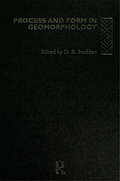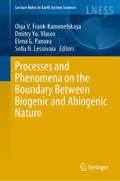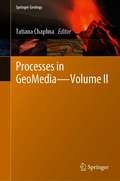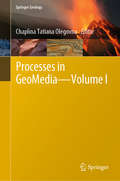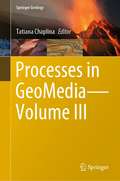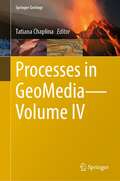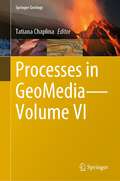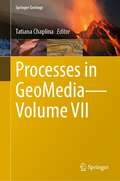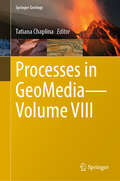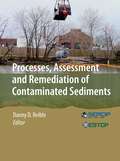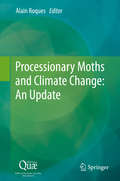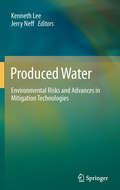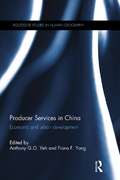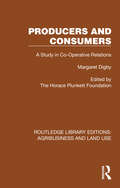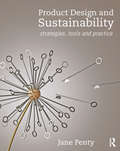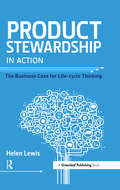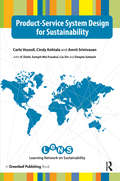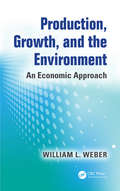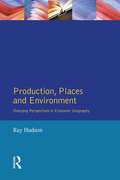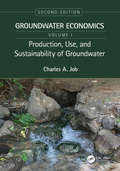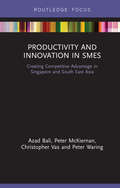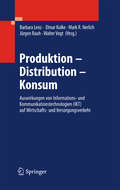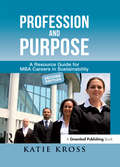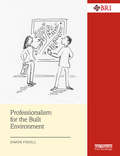- Table View
- List View
Process and Form in Geomorphology
by David StoddartProcess and Form in Geomorphology marks a turning point in geomorphological research. Stoddart has brought together a team of the leading international experts to offer important new studies into the processes, theory and history of landforms, and to present a framework for taking research forward into the new millenium. Illustrated throughout, Process and Form in Geomorphology takes up the challenges of the research agenda set by Richard Chorley and offers fresh insights into his unique contribution.
Processes and Phenomena on the Boundary Between Biogenic and Abiogenic Nature (Lecture Notes in Earth System Sciences)
by Olga V. Frank-Kamenetskaya Elena G. Panova Dmitry Yu. Vlasov Sofia N. LessovaiaThe book represents a collection of papers presented at VI International Symposium "Biogenic - abiogenic interactions in natural and anthropogenic systems" that was held on 24-27 September 2018 in Saint Petersburg (Russia). Papers in this book cover a wide range of topics connecting with interactions between biogenic and abiogenic components in lithosphere, biosphere and technosphere. The main regarding topics are following: methods for studying the interactions between biogenic and abiogenic components; geochemistry of biogenic-abiogenic systems; biomineralization and nature-like materials and technologies; medical geology; biomineralogy and organic mineralogy; biomineral interactions in soil; biodeterioration of natural and artificial materials; biomineral interactions in extreme environment.
Processes in GeoMedia - Volume II (Springer Geology)
by Tatiana ChaplinaThis book presents the findings of recent theoretical and experimental studies of processes in the atmosphere, oceans, and lithosphere, discussing their interactions, geology. methods of geophysical research, and environmental problems resulting from human impacts. Particularly focusing on the geomechanical aspects of the production of hydrocarbons, including the laborious extraction of oils, it also includes contributions on ecological problems related to the biosphere.
Processes in GeoMedia—Volume I (Springer Geology)
by Chaplina Tatiana OlegovnaThis book presents the findings of recent theoretical and experimental studies of processes in the atmosphere, oceans and lithosphere, discussing their interactions, environmental issues, geology, problems related to human impacts on the environment, and methods of geophysical research. It particularly focuses on the geomechanical aspects of the production of hydrocarbons, including the laborious extraction of oils. Furthermore, it includes contributions on ecological problems of the biosphere.
Processes in GeoMedia—Volume III (Springer Geology)
by Tatiana ChaplinaThis book presents the findings of recent theoretical and experimental studies of processes in the atmosphere, oceans and lithosphere, discussing their interactions, environmental issues, geology, problems related to human impacts on the environment, and methods of geophysical research. It particularly focuses on the geomechanical aspects of the production of hydrocarbons, including the laborious extraction of oils. Furthermore, it includes contributions on ecological problems of the biosphere. This book corresponds to the English edition of the "Processes in GeoMedia," a Russian academic journal focused on new theoretical and experimental studies of the Earth's processes.
Processes in GeoMedia—Volume IV (Springer Geology)
by Tatiana ChaplinaThis book corresponds to the fourth volume of the series focused on Processes in GeoMedia and their research on the dynamic of natural systems - geosphere, hydrosphere, atmosphere, and their interactions-, the human contribution to naturally occurring processes are among the most urgent and essential scientific problems. The widespread introduction of computer technology has allowed calculating complex phenomena, previously unavailable for analysis. The creation and improvement of a new generation of geophysical instruments, remote observing systems based on the ship, aircraft, and satellite allow obtaining a large amount of data to reflect the broad picture of the processes objectively. The articles included in this book also reflect a critical position in laboratory modeling of research in geo-environments and testing.
Processes in GeoMedia—Volume V (Springer Geology)
by Tatiana ChaplinaThis book corresponds to the fifth volume of the series focused on Processes in GeoMedia and their research on the dynamic of natural systems, including theoretical and experimental studies of the processes occurring in the earth's bowels, the ocean, and the atmosphere. This volume pays particular attention to geomechanical aspects of the production of hydrocarbons.This fifth volume of Processes in GeoMedia corresponds to the English edition of the journal Processes in GeoMedia, published originally in Russian.
Processes in GeoMedia—Volume VI (Springer Geology)
by Tatiana ChaplinaThe sixth volume of “Processes in GeoMedia”, connected to the Russian journal with the same name, publishes new results of theoretical and experimental studies of the processes occurring in the bowels of the earth, the ocean, and the atmosphere; particular attention is paid to geomechanical aspects of the production of hydrocarbons, including laboriously extracted oils, and to the ecological problems of the biosphere, the human impact on the environment, methods of geophysical research are within the range of the journal interests.
Processes in GeoMedia—Volume VII (Springer Geology)
by Tatiana ChaplinaThis book includes new results of theoretical and experimental studies of various scales of the processes occurring on the earth including the lithosphere, atmosphere, and hydrosphere. Intensive development of research in these areas is due to several factors: 1) the widespread introduction of computer technology, allowing the calculation of complex phenomena; 2) the invention and improvement of a new generation of geophysical instruments such as remote observation systems based on ships, aircraft, and satellites, providing a large amount of data to objectively reflect a broad picture of the processes; and 3) the development of measurement techniques, creating opportunities for controllable and reproducible laboratory data acquisition for generation of new ideas and concepts. Their recent developments have facilitated our research and understanding of these academic fields. The book enriches the understanding of the geophysical processes taking place in various environments (lithosphere, hydrosphere, and atmosphere), including the anthropogenic one, and it further contributes to their development. This book is a valuable resource for specialists working in the oil, gas, and engineering industry to improve their understandings of the field.
Processes in GeoMedia—Volume VIII (Springer Geology)
by Tatiana ChaplinaThis book includes new results of theoretical and experimental studies of various scales of the processes occurring on the earth including the lithosphere, atmosphere, and hydrosphere. Intensive development of research in these areas is due to several factors: 1) the widespread introduction of computer technology, allowing the calculation of complex phenomena, 2) the invention and improvement of a new generation of geophysical instruments such as remote observation systems based on ships, aircraft, and satellites, providing a large amount of data to objectively reflect a broad picture of the processes, 3) the development of measurement techniques, creating opportunities for controllable and reproducible laboratory data acquisition for generation of new ideas and concepts. Their recent developments have facilitated our research and understanding of these academic fields. The book enriches the understanding of the geophysical processes taking place in various environments (lithosphere, hydrosphere, atmosphere), including the anthropogenic one, and it further contributes to their development. This collected research is a valuable resource for specialists working in the oil, gas, and engineering industry to improve their understandings of the field.
Processes, Assessment and Remediation of Contaminated Sediments
by Danny D. ReibleThe purpose of this book is to help engineers and scientists better understand contaminated sediment sites and identify and design remedial approaches that are more efficient and effective. Contaminated sediment management is a difficult and costly exercise that is rarely addressed with easily identified and implemented remedies. It is hoped that this book can help identify and implement management approaches that provide an optimal, if not entirely satisfactory, solution to sediment contaminant problems.
Processionary Moths and Climate Change: An Update
by Alain RoquesBecause of its peculiar biology, its negative impacts on forestry, and its urticating larvae affecting human and animal health, pine processionary moth has largely been studied in many European countries during the last century. However, knowledge remained scattered and no synthesis has ever been published. Since the IPCC retained the moth as one of the two insect indicators of climate change because of its expansion with warming up, filling this gap became increasingly important. Led by INRA, this book associates 101 authors from 22 countries of Europe, Minor Asia and North Africa, combining all the concerned research fields (entomology, ecology, genetics, mathematical modelling, medical and veterinary science, pest management) in a multidisciplinary approach to understand and model the processes underlying past, present and future moth expansion and to propose adapted management methods. Besides, the major biological patterns of the related processionary species are also detailed.
Produced Water
by Jerry Neff Kenneth LeeA state-of-the-art review of scientific knowledge on the environmental risk of ocean discharge of produced water and advances in mitigation technologies. In offshore oil and gas operations, produced water (the water produced with oil or gas from a well) accounts for the largest waste stream (in terms of volume discharged). Its discharge is continuous during oil and gas production and typically increases in volume over the lifetime of an offshore production platform. Produced water discharge as waste into the ocean has become an environmental concern because of its potential contaminant content. Environmental risk assessments of ocean discharge of produced water have yielded different results. For example, several laboratory and field studies have shown that significant acute toxic effects cannot be detected beyond the "point of discharge" due to rapid dilution in the receiving waters. However, there is some preliminary evidence of chronic sub-lethal impacts in biota associated with the discharge of produced water from oil and gas fields within the North Sea. As the composition and concentration of potential produced water contaminants may vary from one geologic formation to another, this conference also highlights the results of recent studies in Atlantic Canada.
Producer Services in China: Economic and Urban Development (Routledge Studies in Human Geography)
by Anthony G.O. Yeh Fiona F. YangIn the past three decades, China has experienced an unprecedented pace of economic and urban development. It’s economy is now transforming from one based on manufacturing industries towards the producer services, with the importance of these services in the national and regional economy being recognized by economists and policy makers alike. With growing demand and policy support, producer services are expected to expand rapidly, leading to a new wave of economic and urban development in China. This groundbreaking volume is one of the first to address questions related to the development of these services in China. The contributions explore a wide range of associated topics including the characteristics of the growth of producer services and how this is related to China’s economic and urban transition, the distribution of these services amongst Chinese cities, as well as drawing comparison between producer service development in China and Western counterparts. This volume also discusses the dynamics of the development of these services in China and how the political-economic embeddedness of China has shaped the development of producer services. Finally, the consequences of this growth and how the economy and urban space have change in response is explored, as well as the challenges Chinese cities face in moving towards a service economy, and how this can inform future public policies. This volume addresses the pressing need to understand the economic and urban changes in post-industrial China to allow appropriate strategies and policies to formulated to facilitate future development in China. The text is rich with statistical data and diagrams, providing original contributions and a cutting edge overview. This timely publication will be of interest to upper-level undergraduates, postgraduates, and researchers interested in China, Urban Studies and Economic Development.
Producers and Consumers: A Study in Co-Operative Relations (Routledge Library Editions: Agribusiness and Land Use #6)
by Margaret DigbyAlthough originally published in 1928, many of the issues discussed in this book remain pertinent today: in unstable markets grappling with labour shortages, how to pay the producers of food a fair price, at a price the consumer can afford, whilst maximising efficiency and minimising waste. Against this backdrop, the book discusses co-operative movements from the UK, Denmark, New Zealand, the former USSR and the USA.
Product Design and Sustainability: Strategies, Tools and Practice
by Jane PentyWhether it is the effects of climate change, the avalanche of electronic and plastic waste or the substandard living and working conditions of billions of our fellow global citizens, our ability to deal with unsustainability will define the twenty-first century. Given that most consumption is mediated through products and services, the critical question for designers is: How can we radically reshape these into tools for sustainable living? As a guide and reference text, Product Design and Sustainability provides design students, practitioners and educators with the breadth and depth needed to integrate the most appropriate sustainable strategies into their practice. It establishes the principles that underpin sustainability and introduces a diverse range of social, economic and environmental design responses and tools available to designers. The numerous real-world examples illustrate how these strategies play out in different product sectors and reinforce the view that sustainability is the most positive opportunity and creative challenge facing designers today. This book: delivers a comprehensive guide to the principles of sustainability and how they apply to product design that can readily be integrated into curricula and design practice reveals many of the issues specific product sectors are facing, and provides the depth and breadth needed for formulating and developing sustainable design strategies to address these issues empowers and inspires designers to engage with sustainability through its many examples and insightful interviews with practitioners is fully illustrated with over 300 photographs, graphs and diagrams and supported by chapter summaries, annotated further reading suggestions, and a glossary.
Product Stewardship in Action: The Business Case for Life-cycle Thinking
by Helen LewisProduct Stewardship in Action describes how and why leading companies are taking responsibility for the environmental impact of their products and packaging. Product stewardship, often referred to as "extended producer responsibility" or EPR, is the idea that everyone that benefits commercially from a product, including manufacturers, distributors and retailers, has a shared responsibility to minimize its environmental impacts. Written primarily for a business audience, it draws on the knowledge and experience of industry practitioners and other experts to provide a structured approach to product responsibility within firms. This will help those new to the field, as well as more experienced practitioners, to develop an effective response to stakeholder concerns about the environmental impacts of their products and packaging. Unlike other resources on product stewardship and EPR, which tend to focus on the design or evaluation of public policy, this book highlights the business case for action. It argues that companies can achieve "shared value" — both public and commercial value — when they take a proactive and knowledge-based approach to the life-cycle management of their products. Product Stewardship in Action focuses on product stewardship as an effective business strategy rather than a philanthropic exercise. To be effective it needs to be based on a good understanding of product impacts and stakeholder concerns, and the risks and opportunities that these present to the business. The most effective responses will be those that address material issues in the product life-cycle while supporting the achievement of other corporate goals and priorities.
Product-Service System Design for Sustainability: Chinese Edition
by Carlo Vezzoli Cindy Kohtala Amrit Srinivasan Liu Xin Moi Fusakul Deepta Sateesh J.C. DiehlThis book, based on a huge European and Asian research project, is a state-of-the-art examination of the theory and practice of system innovation through Product-Service System (PSS) design for sustainability from a trans-cultural viewpoint. PSS design incorporates innovative strategies that shift businesses away from simply designing and selling physical products to developing integrated systems of products and services that satisfy human needs. The book provides background, advice and tools for designers interested in sustainable PSSs and has a wealth of case studies for practitioners to digest.
Production, Growth, and the Environment: An Economic Approach
by William L. WeberWritten in a way that facilitates understanding of complex concepts, laws, and policy, Production, Growth, and the Environment: An Economic Approach explores how economic growth usually makes people better off, but also asks at what environmental cost? These costs are not often realized until after the fact, when their remediation is more expensive
Production, Places and Environment
by Ray HudsonDrawing upon 25 years of original research, Production, Places and Environment provides a unique combination of rich, varied and theoretically informed case studies, along with more general analyses of processes and changing theoretical and methodological perspectives in economic geography that are informed by original empirical research.Through a huge range of his own groundbreaking case material the author explores such essential factors as space, production, social and political concerns, and environmental issues, being careful to ground the more complex theory in the more general tendencies in economic geography and the social sciences.
Production, Use, and Sustainability of Groundwater: Groundwater Economics, Volume 1
by Charles A. JobGroundwater is becoming increasingly scarce while the demand for water continues to grow at a global scale. Understanding groundwater resources and their sustainable management is imperative for the future of groundwater use, conservation and protection. This revised and updated two-volume set, focused on sustainability, covers the economic values of groundwater production and use, including micro- and macroeconomic factors, groundwater markets, economic evaluation tools, climate change, transboundary issues and policy evaluation. It explores numerous applications and describes ways to evaluate the economics of groundwater use in the context of the larger ecosystem and the natural capital it provides. FEATURES OF THIS VOLUME Includes an important new chapter on groundwater sustainability management Addresses new examples of groundwater use that are applicable at both the local and international levels Provides the foundation for policy, program and project analysis for all major uses of groundwater Updates groundwater use data along with explanations of major production costs and use benefits Gives a new perspective on users’ competition for the subsurface environment Production, Use, and Sustainability of Groundwater, Second Edition, the first volume of the two-volume set Groundwater Economics, is a must-have for any professional or student who needs to understand, evaluate and manage water resources from a range of production and use perspectives affecting groundwater resource sustainability.
Productivity and Innovation in SMEs: Creating Competitive Advantage in Singapore and South East Asia (Routledge Focus on Environment and Sustainability)
by Peter McKiernan Azad Bali Christopher Vas Peter WaringThis book analyses the determining factors behind productivity and innovation amongst Small and Medium Enterprises (SMEs) in Singapore, and within the context of South East Asia, in order to offer recommendations for increasing productivity and aiding economic growth. SME firms are an influential driver of economic growth in advanced world economies like the USA, Germany, Japan and South Korea. Throughout the 2000s, Singapore experienced a decline in economic growth which was linked to decreasing productivity in its SMEs. The decline triggered a transformational policy by a Government intent on forging a ‘high skill–high productivity’ future. Given substantial evidence that low productivity growth occurred in sectors where immigrants dominated the workforce, the seeds of recovery focused on improving productivity and innovation amongst SMEs in those sectors. Hence, this book investigates the factors determining productivity amongst SMEs across the manufacturing sector. It utilises personal interviews with global experts and CEOs, combined with primary data collected from a major international Delphi survey, and interviews with 215 SME owners and managers in Singapore. This data helps us to better understand how these productivity-enhancing factors can be used to increase performance amongst SMEs. By investigating the nature and process of total factor productivity in Singapore’s SMEs, this book tells the policy story behind the revolution. To provide a comparative analysis, Singapore’s story is placed within a South East Asian context. The unfolding narrative contains important lessons for policy makers and industry globally, as they assess the strategic choices available to them for improving productivity and innovation. This book will be of great interest to students and scholars of innovation and productivity, as well as economic development officers, government policy advisors, SME business managers and sustainable businesses.
Produktion - Distribution - Konsum
by Elmar Kulke Barbara Lenz Jürgen Rauh Mark R. Nerlich Walter VogtDie zunehmende Bedeutung von Informationsflüssen für die Wertschöpfung geht einher mit einer wachsenden Kohärenz der Wertschöpfungsketten. Kenntnisse darüber sind für die strategische Planung in der Politik wie in Unternehmen gleichermaßen wichtig. Die Beiträge des Buchs untersuchen die Auswirkungen von Informations- und Kommunikationstechnologien auf Güter- und Informationsflüsse zwischen Herstellern und Endverbrauchern. Dazu werden Güter- und Informationsflüsse entlang von Produktions- und Distributionsprozessen dargestellt und analysiert.
Profession and Purpose: A Resource Guide for MBA Careers in Sustainability
by Katie KrossSustainability holds the promise of an exciting new approach to business – one in which business goals are aligned with social and environmental goals. Multinational corporations are recognizing that we live in an increasingly resource-constrained world, and that more accountability for corporate social and environmental impacts will accrue to them. More importantly, forward-thinking executives understand that sustainability can present new opportunities for competitive advantage – whether that is by reducing costs, minimizing risk, appealing to increasingly conscientious customers, or reaching new markets entirely.With the growth of this field comes a host of interesting new career opportunities for MBAs. As companies are grappling with challenges like how to develop social return on investment (SROI) metrics or understand the potential impact of corporate carbon footprints on stock prices, there are new opportunities for the next generation of managers – managers who are not only trained in traditional MBA fundamentals but also grounded in an understanding of the multifaceted social and environmental challenges facing 21st-century global business leaders. Entirely new career paths are opening to MBAs interested in sustainability: sustainable venture capital, green marketing, corporate social responsibility management, carbon credit trading, and sustainability consulting, to name a few.Perhaps even more than corporate executives, MBA students understand this trend. The next generation of managers can see that the future of business will require a new set of skills and responsibilities. Between 2003 and 2008, membership in Net Impact, the global organization for MBAs and business professionals interested in sustainability, increased more than fourfold. By March 2009, over 130 business schools had a Net Impact chapter. Around the world, MBA students realize that a different model will be required for businesses in the coming decades. The career paths that fall under the broad umbrella of "sustainability" are as diverse as the MBA students themselves. One student may be interested in social entrepreneurship in West Africa, and the next will be seeking advice about clean-tech venture capital careers in Silicon Valley; a third will be interested in greening global supply chains. Corporate social responsibility, sustainable product marketing, microfinance, green real estate development, renewable energy, and other interests all likewise fall under the sustainability umbrella at times. Because of this diversity, it is often hard for business schools' career management centers to address sustainability-related career options in a comprehensive way. Many sustainability-related companies and nonprofits are not accustomed to on-campus recruiting. Others have not historically hired MBAs at all. MBA students and alumni interested in sustainability careers are often left to navigate their own internship and job search paths. And, often, they struggle. Profession and Purpose has been written to address this urgent need. Whether you are focused on an off-campus search or participating in the on-campus recruiting process, there are a host of sustainability-specific career resources you should know about. You'll need to be well versed in sustainability news and trends, and network at the right events, conferences, and company presentations. You also need to know about industry- and discipline-specific websites that post sustainability jobs for positions with titles like Corporate Social Responsibility Manager, Socially Responsible Investing Analyst, and Renewable Energy Market Analyst.Through hundreds of conversations with MBA students, professionals, and recruiters, as well as her own personal experience, the author has compiled the key job search resources and tips for MBAs interested in sustainability careers. The book provides ideas for researching companies, making the most of your networking, identifying job and internship openings, and preparing for interviews. No matter what stage of your MBA career search process you're in, this
Professionalism for the Built Environment (Building Research and Information)
by Simon FoxellIn the aftermath of the Grenfell Tower tragedy, this new book provides thought provoking commentary on the nature of the relationship between society, the prevailing economic system and professionalism in the built environment. It addresses the changing responsibilities of professionals and in particular their obligation to act in the wider public interest. It is both an introduction to and an examination of professionalism and professional bodies in the sector, including a view of the future of professionalism and the organisations serving it. Simon Foxell outlines the history of professionalism in the sector, comparing and contrasting the development of the three major historic professions working in the construction industry: civil engineering, architecture and surveying. He examines how their systems have developed over time, up to the current period dominated by large professional services firms, and looks at some options for the future, whilst asking difficult questions about ethics, training, education, public trust and expectation from within and outside the industry. The book concludes with a six-point plan to help, if not ensure, that the professions remain an effective and essential part of both society and the economy; a part that allows the system to operate smoothly and easily, but also fairly and to the benefit of all. Essential reading for built environment professionals and students doing the professional studies elements of their training or in the process of applying for chartership or registration. The issues and lessons are applicable across all building professions.
